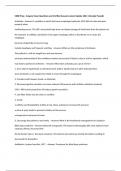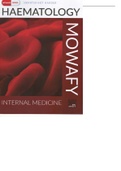CDRE Prep - Surgery Exam Questions and Verified Answers Latest Update 2024 ( Already Passed)
Achalasia - Answers A condition in which the lower esophageal sphincter (LES) fails to relax and open
properly when
swallowing occurs. The LES's excessively high tone can impair passage of food bolus from the pharynx to
the stomach. In addition, peristalsis in the upper esophagus often is disordered. As a result, the
esophagus
becomes shaped like a funnel or bag.
include dysphagia and frequent vomiting. - Answers What are the symptoms of Achalasia
The patient is a risk for weight loss and may become
seriously malnourished if the condition remains uncorrected. Patient is also at risk for aspiration, which
may lead to pulmonary infection. - Answers What does achalasia put a pt at risk for?
1. Give solid or liquid foods as tolerated (semi-solid or liquid foods are often tolerated best,
since peristalsis is not required for fluids to move through the esophagus).
2. Provide small frequent meals, as tolerated.
3. Decreased gastrin secretion can cause reduced LES pressure and facilitate relaxation (reduced
CHO + PRO and increased fat will reduce gastrin secretion).
4. Low fiber foods may be easier to swallow.
5. Avoid:
• caffeine and theophylline (coffee & tea), these substances increase LES pressure
• citrus & spicy foods to prevent irritation of the mucosa
• temperature extremes in foods
6. Encourage the patient to eat slowly. - Answers What is the Nutritional management for achalasia
Blind loop syndrome - Answers Bacterial overgrowth. The bacteria deconjugate bile acids. Bacteria have
cytotoxic effects: decrease CHO
(brush border injury + decrease enzymes). The bacteria also decrease micelle formation resulting in
decreased fat absorption.
Antibiotics, lactose free diet, MCT. - Answers Treatment for blind loop syndrome
,C difficile - Answers A gram positive, spore-forming, anaerobic microbe that can cause
pseudomembranous
colitis.
Individuals with celiac disease have a non-allergic
sensitivity to the gliadin fraction of gluten in wheat, rye, barley, triticale and oats, which causes villus
atrophy in the small bowel and results in the malabsorption of all macronutrients, fat soluble vitamins,
Fe,
folate, and B12. - Answers describe celiac disease
diarrhea, steatorrhea, foul-smelling bulky stools, bloating, cramping, exacerbations &
remissions, weight loss, anemia, malnutrition, failure to thrive, irritability (behavior disturbances), may
develop secondary lactose intolerance d/t damaged enterocytes (results in decrease in disaccharidases).
- Answers What are the symptoms of celiac
1. Avoid all foods with wheat, rye, barley, triticale, sorghum, millet, bulgar, oats, and their
derivatives
2. Substitute with corn, rice, potato, soybean, tapioca, sago arrowroot flours
3. Patients must learn to read labels carefully, unless certain brands are gluten free, need to be
cautious about cereal-based beverages (Ovaltine, Postum, beer, ale, instant coffee), ice cream
(d/t gluten stabilizers), salad dressing, canned/processed meats, creamed soups, mustard,
catsup, chocolate milk, processed cheese, hydrolyzed vegetable protein
4. May need lactose free diet - Answers What is the nutritional management of celiac
Cholecystitis - Answers inflammation of the gallbladder; obstruction of the cystic duct; may result in
steatorrhea or malabsorption that has nothing to do with the intestine.
Cholelithiasis: - Answers the formation of gallstones without infection.
Choledocholithiasis: - Answers develops when gallstones enter the common bile duct causing
obstruction.
1. middle age
2. multiple pregnancies
, 3. obesity (rapid weight loss may have influence on gallbladder function)
4. female to male incidence is 3:1
5. more common in western countries
Other predisposing factors:
1. refined CHO diet (low fiber diet)
2. drug use (i.e. oral contraceptives and lipid lowering medication)
3. surgical procedures (i.e. ileal resection)
4. rapid weight loss (very low calorie diets)
5. diabetes - Answers What are the factors that increase gallbladder disease
there is no evidence to suggest that a low fat diet is beneficial (Vezina, 1998), following CFG
recommendations is most prudent (≤30% calories from fat)
• gradual weight loss if indicated
• high fiber diet
• reduction of cholesterol shows no benefit - Answers nutritional management of Chronic Cholelithiasis
a diet moderately restricted in fat may be beneficial as fatty acids stimulate contraction of the
gallbladder via cholecystokinin (CCK) - Answers Nutritional management of Acute Cholecystitis and
Choledocholithias
there is no indication for the restriction of fat intake post surgery
• the bile duct will eventually dilate and take over the function of the gallbladder
• some patients may benefit from a diet moderately restricted in fat (25% calories from fat) to
decrease pain with stimulating the Sphincter of Oddi - Answers Nutritional management of
Cholecystectomy
Crohns - Answers An inflammatory bowel disease that can occur at any age but more commonly occurs
between ages 15-30
years and 50-60 years. A chronic inflammation occurs in all gut wall layers of affected bowel, including
mesentery and lymph nodes. There may be lesions from mouth to anus.





